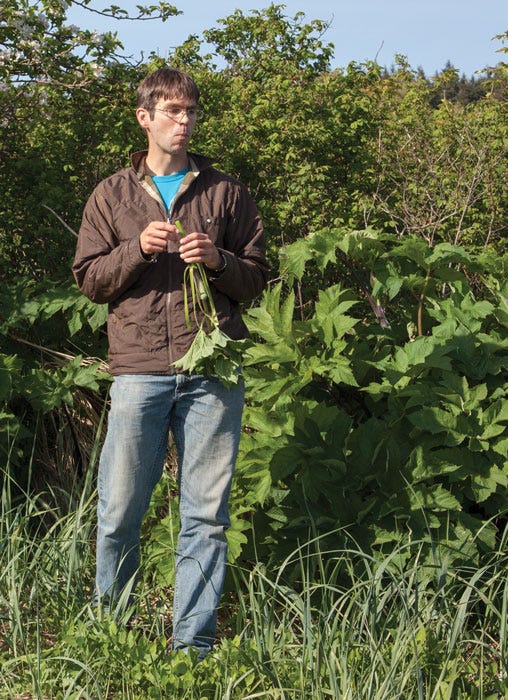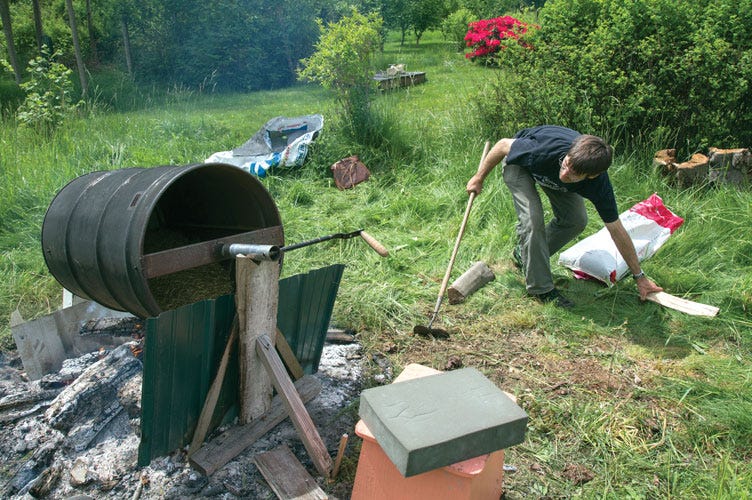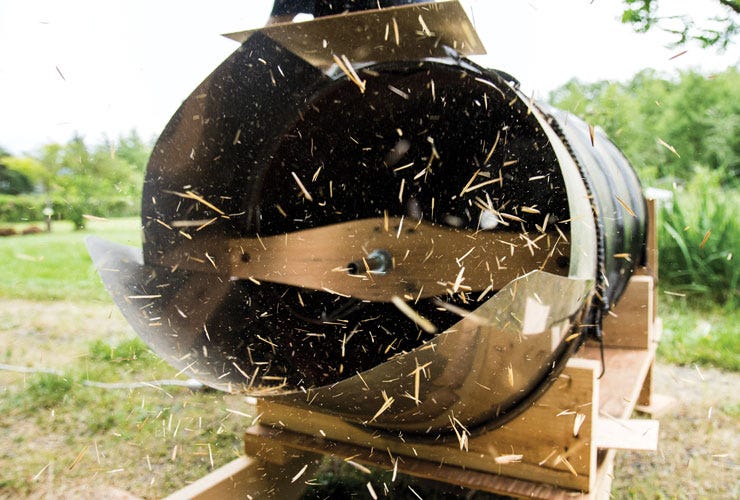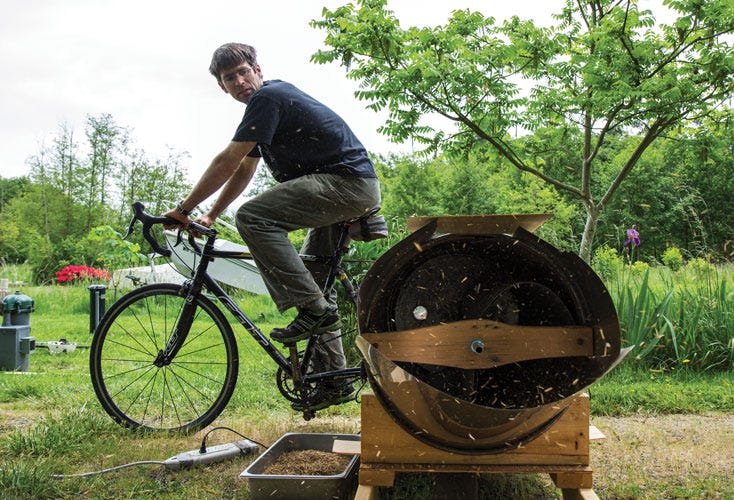Wonders of the Wilderness
Local foragers enriched by wild food
STORY BY MICHELLE DUTRO
photo by Evan Abell
(above) Abe Lloyd pours maple syrup into a blender while making a smoothie using mostly items he foraged around Whatcom County.
Bushy eyebrows raised slightly over his wire-rimmed glasses, Abe Lloyd looks excitedly at a small ditch. The green stalks of a salmonberry plant, not yet ripe with orange berries, have caught his eye. Crouching down, Lloyd whips out a pocket knife and gently cuts off part of the plant. After peeling the skin off the outside of the stalk, he breaks off a piece and pops it in his mouth.
Lloyd is foraging around a small inlet of Chuckanut Bay. Most people might not look at the side of the road as a snacking opportunity, but for Lloyd, who has built his life around foraged wild foods, every casual walk is a time to graze on nature’s bounty.
Lloyd’s childhood is ripe with memories of hunting for wild foods: making tunnels through the vines of Himalayan blackberries, trying bitter-tasting dandelions, checking out plant identification books from the Bellingham Public Library and staying up at night memorizing different species.

“As I got older, I realized indigenous people have been doing this for thousands of years,” Lloyd says. “And it wasn’t a novel thing at all, but really a way of life that has sustained people for countless generations.”
With the resurgence of “going green,” Western banned sales of bottled water and Bellingham banned sales of plastic grocery bags, but Lloyd, a Western adjunct professor, feels the disconnection between consumers and their food is making it difficult to develop a real conservation ethic.
“There’s a resurgence in our society relating to the importance of protecting the environment, but I think it’s hard for people to connect with because they don’t have much opportunity to actually be in the environment, so they see it as a place where humans shouldn’t necessarily be,” Lloyd says. “If we’re going to live as part of the world, we need to learn to balance our economy within the stabilities of the ecosystems.”
Approximately 70 percent of Lloyd’s diet is supplemented by foraged food during peak seasons in spring and summer. He finds most food around his hometown of Bellingham, but Lloyd has also foraged beyond his childhood stomping grounds, traveling to places such as Idaho, where he harvested more than 400 pounds of wild rice in a single weekend in 2013.
Wild rice grows primarily in shallow lakes and ponds as a tall, wheat-like stalk. No commercial wild rice processing facilities exist in Washington, so Lloyd does it himself.
Lloyd starts by pouring about 15 pounds of rice into a 55-gallon barrel. Welded onto each end of the barrel are metal rods that balance on two wooden stilts to position the barrel over a roaring fire. Lloyd slow roasts the rice, turning a hand crank to gently spin the barrel, heating the rice to 280 degrees Fahrenheit. This makes separating the hull from the grain easier.
The smell of roasted rice wafts through the air. “The best way I can think to describe the smell is green,” Lloyd says, sifting the warm rice through his hands.

After the rice cools, Lloyd transfers it to another barrel. The next stage of the process uses an elaborate, homemade contraption.
Inside the barrel are two metal paddles that, when turned, push against the rice, removing the hulls. Lloyd doesn’t use electricity to turn the paddles. Instead, he connects the rear gear of his road bike to spin the paddles. Through a hole in one end of the barrel, a small hair dryer blows warm air, pushing out the removed hulls in clouds.
Lloyd is left with long, black grains, completely separated from their hulls and ready to cook.
Jennifer Hahn, an adjunct professor who teaches a Wild Foods class at Fairhaven College and Lloyd’s friend, also grew up foraging.
“I wanted to walk down a trail and see food and medicine everywhere. I had that dream,” Hahn says. “I wanted to someday not just look at the vague scribble of green that one sees when they look at Sehome Hill, but to see individual species and know what they’re used for.”
Kayaking from Alaska to Bellingham during the spring and summer from 1992–1995, Hahn says she lived by the rhythms of the moon and tides. When the animals ate at low tide, she would forage for seaweed. When she discovered berries in animals’ feces, she would search for berries, she says.
“To me, foraging is the most elemental connection that we have with the planet,” Hahn says. “There’s nothing more intimate than eating wild food, because you’re taking something that has grown here for millions of years and it gives you the ability to survive.”

Lloyd has built his life around wild foods in a similar way.
His home is filled with jars of preserved wild food: crab apples, stinging nettle seeds, maple syrup, various ground roots, dried bare-stem desert parsley leaves and dried morel mushrooms, to name a few.
A visitor to Lloyd’s home might find strands of bull kelp strung out on a clothesline like drying laundry.
Much of Lloyd’s inspiration comes from the food traditions of several First Nations and Northwest coastal tribes.
His fascination with traditional native uses for wild foods blossomed when he was 18. Lloyd canoed for eight weeks with his dad and a friend along the northern coast of Vancouver Island, B.C. They supplemented a large part of their diet with foraged food. One day, the group stopped their canoes on Gilford Island and discovered some First Nations tribal members drying red laver seaweed on the beach, Lloyd says.
“It was so much better than anything we were eating,” Lloyd says.

The diversity of plants and animals eaten by indigenous peoples is enormous compared with the typical American diet, Lloyd says. Archaeologists have found remains of more than 300 species eaten by the Coast Salish alone, he says.
“In the American diet we just eat different combinations of beef, corn and tomatoes, and we could call it Italian, American or McDonalds; it’s always kind of the same,” Lloyd says. “I think that’s a high point of the wild food diet — the diversity it can offer and the flavor.”
Fairhaven senior Kate Rhodes often forages around Bellingham on her way to school or work. She also uses native plants for medicinal purposes.
After getting scratches from foraging in the woods or from playing too hard with her cat, Rhodes says she often makes a healing plant spray. She combines cedar leaves, Oregon grape leaves, saxifrage and a couple drops of lavender essential oil to soothe her cuts.
“To me, foraging is the most elemental connection that we have with the planet. There’s nothing more intimate than eating wild food.”
Lloyd believes one of the most powerful medicines is food. As more people suffer from diseases — such as diabetes and obesity — related to poor diet, healthy eating has come to the forefront of conversation, he says.
“I think on a more primal or spiritual level, [foraging] really connects us to the land because we pick something, eat it and it nourishes us,” Lloyd says. “I think that’s kind of profound, because we don’t get that when we buy food from the grocery store.”
When consumers are separated from their food by eating out of season and buying food in a grocery store, food can become more of a commodity, Lloyd says.
Whether he is snacking on salmonberry stalks by Chuckanut Bay, searching the woods for stinging nettles on Squalicum Mountain or scouring fallen logs for mushrooms around Lake Padden, Lloyd says foraging helps him be a better environmental steward.
